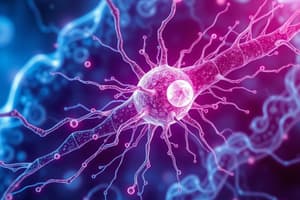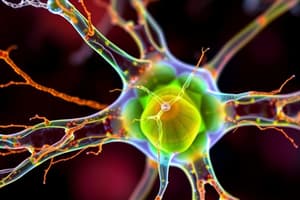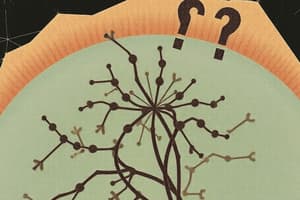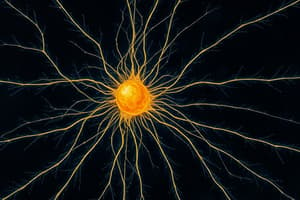Podcast
Questions and Answers
Which type of cytoskeletal filament is primarily responsible for the bending of microvilli?
Which type of cytoskeletal filament is primarily responsible for the bending of microvilli?
- Microtubules
- Microfilaments (correct)
- Intermediate filaments
- Myosin filaments
Which of the following is NOT a primary function of microvilli?
Which of the following is NOT a primary function of microvilli?
- Cell division (correct)
- Increasing surface area for absorption
- Ion transport
- Nutrient absorption
Which cytoskeletal structure is the largest in diameter and often involved in intracellular transport of organelles
Which cytoskeletal structure is the largest in diameter and often involved in intracellular transport of organelles
- Intermediate filaments
- Microfilaments
- Microtubules (correct)
- Myosin filaments
Which type of cell junction is characterized by its ability to allow small molecules to move between adjacent cells?
Which type of cell junction is characterized by its ability to allow small molecules to move between adjacent cells?
Which of the following is NOT a component of intermediate filaments in cells?
Which of the following is NOT a component of intermediate filaments in cells?
Which type of junction is known for making a cell layer impermeable to certain substances?
Which type of junction is known for making a cell layer impermeable to certain substances?
The protein subunits that make up microtubules are called?
The protein subunits that make up microtubules are called?
Which cytoskeletal element is most associated with muscle contraction?
Which cytoskeletal element is most associated with muscle contraction?
Flashcards
Cytoskeleton
Cytoskeleton
A complex network of protein filaments and tubules that extends throughout the cytoplasm, providing structural support and facilitating movement within the cell.
Microtubules
Microtubules
The largest filaments in the cytoskeleton. They are hollow, unbranched structures composed of tubulin protein subunits.
Microfilaments
Microfilaments
The thinnest structures of the cytoskeleton, composed of the protein actin, they play key roles in cell shape and movement.
Intermediate filaments
Intermediate filaments
Signup and view all the flashcards
Cell Junctions
Cell Junctions
Signup and view all the flashcards
Tight Junctions
Tight Junctions
Signup and view all the flashcards
Adherens junctions
Adherens junctions
Signup and view all the flashcards
Microvilli
Microvilli
Signup and view all the flashcards
Study Notes
Cytoskeleton of a Cell
- The cytoskeleton is a network of protein filaments and tubules that extend throughout the cytoplasm.
- It forms the framework of the cell's structure.
Cytoskeleton Types
- The cytoskeleton has three main types:
- Microtubules
- Microfilaments
- Intermediate filaments
Microtubules
- These are the largest filaments within the cytoskeleton.
- They are found in most cells, except red blood cells.
- Microtubules are hollow and unbranched, composed of two protein subunits of tubulin.
- They are involved in:
- Determining cell shape
- Organelle movement
- Movement of secretory granules
- Intracellular transport
- Microtubules originate from the centrosome.
- They are most visible in cilia and flagella.
Microfilaments
- The thinnest structures within the cytoskeleton, composed of the protein actin.
- They help shape cells.
- They provide structural support and are anchors at cell junctions.
- They form the core of microvilli and cilia.
- In muscle cells (skeletal and cardiac), actin filaments interact with myosin proteins for muscle contraction.
- They are responsible for cell movements like:
- Bending of microvilli
- Contraction of pseudopodia
- Formation during cell division
Intermediate Filaments
- Thicker than microfilaments, like strong, permanent guy wires.
- They are the most permanent components of the cytoskeleton.
- They are involved in many cellular functions.
- They are part of a variety of other filaments found in cells, including:
- Myosin filaments of sarcomeres
- Tono filaments of desmosomes
- Neuro filaments in neurons
- Keratin filaments at the apical end of epithelial cells
- Lamin filaments within the nuclear membrane
- They are part of a variety of other filaments found in cells, including:
Cell Junctions
- Tight junctions: extremely close to each other, often impermeable to substances, transmembrane linker proteins
- Adherens junctions: transmembrane linker proteins
- Desmosomes: anchoring junctions where filaments anchor, including
- Macula adherens (desmosomes)
- Hemidesmosomes
- Septate desmosomes
- Gap junctions: allow small molecules to pass between cells.
Apical Surface (Cell Surface)
- Microvilli are finger-like extensions of the plasma membrane of epithelial cells, increasing the surface area for absorption of nutrients (small intestine) and ion transport (kidneys).
Cilia
- Whip-like, motile extensions of the apical surface membranes.
- Found in respiratory systems, fallopian tubes in humans and some protozoa.
Flagella
- Long isolated cilia, typically found in sperm cells in humans and some protozoa like Euglena.
Ciliary Structure
- The wall of cilia consists of 9 sets of microtubule pairs surrounding 2 central microtubules
Pseudopodia (False Feet)
- Amoeboid movement for cells like phagocytic cells (white blood cells) and amoebas.
Functions of Cilia
- Movement of foreign particles away in the respiratory system.
- Movement of ova in the fallopian tubes.
Functions of Flagella
- Movement and swimming.
Studying That Suits You
Use AI to generate personalized quizzes and flashcards to suit your learning preferences.




